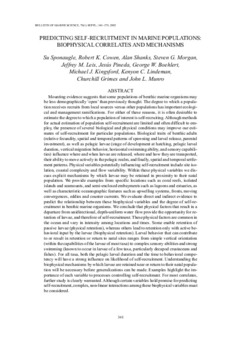Predicting self-recruitment in marine populations: biophysical correlates and mechanisms
Abstract
Mounting evidence suggests that some populations of benthic marine organisms may be less demographically ‘open’ than previously thought. The degree to which a population receives recruits from local sources versus other populations has important ecological and management ramifications. For either of these reasons, it is often desirable to estimate the degree to which a population of interest is self-recruiting. Although methods for actual estimation of population self-recruitment are limited and often difficult to employ, the presence of several biological and physical conditions may improve our estimates of self-recruitment for particular populations. Biological traits of benthic adults (relative fecundity, spatial and temporal patterns of spawning and larval release, parental investment), as well as pelagic larvae (stage of development at hatching, pelagic larval duration, vertical migration behavior, horizontal swimming ability, and sensory capabilities) influence where and when larvae are released, where and how they are transported, their ability to move actively in the pelagic realm, and finally, spatial and temporal settlement patterns

